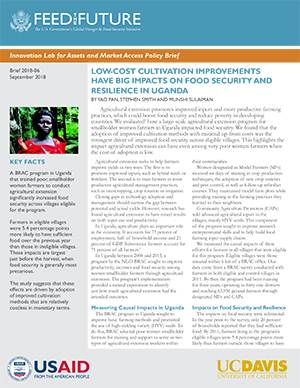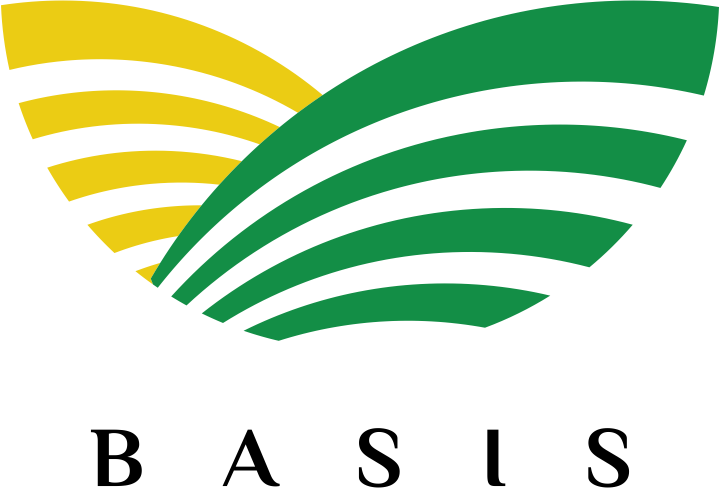
Agricultural extension promotes improved inputs and more productive farming practices, which could boost food security and reduce poverty in developing countries. We evaluated[1] how a large-scale agricultural extension program for smallholder women farmers in Uganda impacted food security.
We found that the adoption of improved cultivation methods with minimal up-front costs was the strongest driver of improved food security across eligible villages. This highlights the impact agricultural extension can have even among very poor women farmers when the cost of adoption is low.
Highlights
- A BRAC program in Uganda that trained poor, smallholder women farmers to conduct agricultural extension significantly increased food security across villages eligible for the program.
- Farmers in eligible villages were 5.4 percentage points more likely to have sufficient food over the previous year than those in ineligible villages. These impacts are largest just before the harvest, when food security is generally most precarious.
- The study suggests that these effects are driven by adoption of improved cultivation methods that are relatively costless in monetary terms.
Agricultural extension seeks to help farmers improve yields in two ways. The first is to promote improved inputs, such as hybrid seeds or fertilizer. The second is to train farmers in more productive agricultural management practices, such as intercropping, crop rotation or irrigation.
Closing gaps in technology adoption and management should narrow the gap between potential and actual yields. However, research has found agricultural extension to have mixed results on both input use and productivity.
In Uganda, agriculture plays an important role in the economy. It accounts for 73 percent of employment, half of household income and 21 percent of GDP. Subsistence farmers account for 71 percent of all farmers.[2]
In Uganda between 2008 and 2013, a program by the NGO BRAC sought to improve productivity, incomes and food security among women smallholder farmers through agricultural extension. The program’s implementation provided a natural experiment to identify just how much agricultural extension had the intended outcomes.
Measuring Causal Impacts in Uganda
 The BRAC program in Uganda sought to improve basic farming methods and promoted the use of high-yielding variety (HYV) seeds. To do this, BRAC selected poor women smallholder farmers for training and support to serve as two types of agricultural extension workers within their communities.
The BRAC program in Uganda sought to improve basic farming methods and promoted the use of high-yielding variety (HYV) seeds. To do this, BRAC selected poor women smallholder farmers for training and support to serve as two types of agricultural extension workers within their communities.
Women designated as Model Farmers (MFs) received six days of training in crop production techniques, the adoption of new crop varieties and pest control, as well as follow-up refresher courses. They maintained model farm plots while providing training in the farming practices they learned to their neighbors.
Community Agriculture Promoters (CAPs) sold advanced agricultural inputs in the villages, mainly HYV seeds. This component of the program sought to improve women’s entrepreneurial skills and to help build local farming input supply chains.
We measured the causal impacts of these efforts for farmers in all villages that were eligible for this program. Eligible villages were those situated within 6 km of a BRAC office. Our data come from a BRAC survey conducted with farmers in both eligible and control villages in 2011. By then the program had been running for three years, operating in forty-one districts and reaching 63,936 general farmers through designated MFs and CAPs.
Impacts on Food Security and Resilience
The impacts on food security were substantial. In the year prior to the survey, only 20 percent of households reported that they had sufficient food. By 2011, farmers living in the program’s eligible villages were 5.4 percentage points more likely than farmers outside those villages to have sufficient food over the previous year. Moreover, the impacts were largest just before the harvest, when food security is generally most precarious.
Detailed surveys on consumption also showed significant improvements. In the week prior to the survey, per-capita household food consumption was about 12 percent higher. In the month leading up to the survey, households in villages eligible for the program were 6.2 percentage points less likely to limit their varieties of food and 9.5 percentage points less likely to skip meals.
The agricultural program also helped farmers to better cope with shocks. In the six months prior to the survey, a little over half of households experienced at least one village shock—drought, flood, pest attack, livestock epidemic, fire, or poor-quality seeds. Among these households, those eligible for the program were 8.3 percentage points more likely than ineligible households to reduce consumption and 4.9 percentage points less likely to sell assets. Preserving assets after shocks has potential longer-term benefits by maintaining the capacity for future productivity and food security.
How Extension Drove Impacts
We attribute these impacts on food security to improved cultivation methods that require low cash investment. Farmers in eligible villages were 9.2 percentage points more likely to use organic fertilizer, such as manure, and 3 percentage points more likely to irrigate their land using basic methods. Being eligible for the program also increased intercropping and crop rotation by 6 and 8 percentage points, respectively. Each of these practices mitigates soil erosion and increases yields.[3] In contrast, the adoption rate of improved seeds remained statistically unchanged.
An important question is how gains in food security also improved how households coped with shocks. We can identify potential mechanisms, many of which may have worked together. No doubt greater wealth makes it easier to cope with a shock. Irrigation could have helped farmers to withstand drought and better soil-conserving practices could have reduced flood damage. There could be many other mechanisms but this requires further study.
Promoting Food Security with Extension
Our interpretation of these results is straightforward: when women smallholder farmers adopt basic farming practices that do not require significant cash outlays, crop yields are higher, resulting in increased consumption or agricultural income that both can lead to improved family food security. We found no evidence that these results were driven by an impact on female empowerment and the resulting reallocation of resources within a household.
Enhanced food security was caused by greater adoption of improved cultivation methods as a result of training. Also, while the intervention did not statistically change the use of improved inputs, the cultivation training may have helped farmers to use improved inputs more effectively.
The improved food security is most likely the result of the combined impact of practices promoted by BRAC program. What is particularly remarkable is that an agricultural extension program could bring about such a significant impact on food security primarily through such low-cost activities.
While more research is needed, our results suggest three initial implications. First, specially targeted agricultural extension may offer a cost-effective approach to assist poor women and their children. Second, agricultural extension merits greater focus in efforts to improve food security. Third, while governments usually run extension programs, NGO programs can also be effective, at least for women smallholders.
Yao Pan is an assistant professor of economics at Aalto University.
Stephen C. Smith is a professor of economics and international affairs at George Washington University and recently completed a UNICEF Senior Fellowship.
Munshi Sulaiman is director of research, evaluation and learning for Save the Children and an incoming professor at BRAC University in Bangladesh.
[1] Pan, Y., et al. 2018. “Agricultural Extension and Technology Adoption for Food Security: Evidence from Uganda.” American Journal of Agricultural Economics.
[2] Uganda National Household Survey 2005-6. Uganda Bureau of Statistics.
[3] Liniger, H., et al.2011. “Sustainable Land Management in Practice: Guidelines and Best Practices for Sub-Saharan Africa.” UN FAO.
This report is made possible by the generous support of the American people through the United States Agency for International Development (USAID). The contents are the responsibility of the Feed the Future Innovation Lab for Assets and Market Access and do not necessarily reflect the views of USAID or the United States Government.
